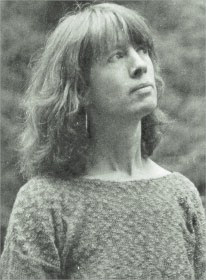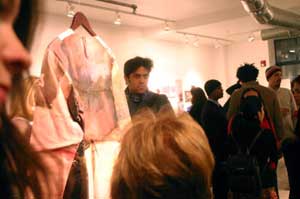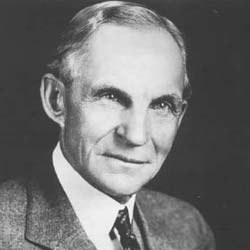Last fall marked the debut of The Analogous Series, a new multimedia events series run by poet and art critic Tim Peterson and hosted in Cambridge. Focusing on curating together poets with visual artists, cultural activists, and interdisciplinary artists experimenting with blurring the lines between disciplines, the series has brought an impressive and diverse list of presenters to Boston. This season’s offerings include upcoming presentations by Lyn Hejinian, Emilie Clark, Joan Jonas, Alan Sondheim and local favorites William Corbett, Ruth Lepson, and Joel Sloman. As the program’s spring season kicks off, Tim Peterson took the time to speak with Big Red and Shiny on the development ofThe Analogous Series and his thoughts on the relationship between poetry and the visual arts.
Tell me about your involvement with the POG Collective in Tucson, Arizona – how is this event series modeled? What sort of influence did POG have on your curatorial approach to organizing the Analogous Series?
POG Collective, a multimedia series based in Tucson, AZ, has been a strong influence on what I’m doing now. Tenney Nathanson and Charles Alexander have a really exciting poetry scene happening in Tucson. POG’s model is to build on something like Apollinaire’s understanding of the interrelationship between poetry and painting, or the scenario evoked by Kenneth Koch’s Fresh Air -- opening up poetry beyond the literary by understanding that the avant-garde was originally and still is a multidisciplinary, multimedia endeavor. I was involved with the Board of Directors for POG several years ago, and am still on the Advisory Board today, and both engagements have been a great learning experience. From pairing Cole Swenson with dancer Eno Washington to pairing Peter Gizzi with visual artist Ann Tracy-Lopez, POG employs a model of presenting artists on an equal footing with writers, showing that writers can be influenced by artists rather than just by other writers. Another reading series that was very influential to me and which learns from POG’s example is the Discrete Series run by Kerri Sonnenberg and Jesse Seldess in Chicago which focuses largely on experimental music and poetry.
When I arrived in Boston in 2002, I was thinking about doing a reading series, but I knew I couldn’t just copy POG. My background is in art history, so I’m lodged between different disciplines. The Analogous Series grew out of my interests in these kinds of collaboration and conversation that happen between media; I realized that I could host artists and writers who actually worked with one another, rather than in discrete presentations, and that the event could be to have them discuss the process of working together. The dominant model of the artist or poet that we still seem to have lodged in our brains, even among poetry “scenes,” is of the artist as an isolated, narcissistic maker in the romantic sense…we seem to want to rank artists in relation to one another as the primary criteria. I want to push that discussion toward the notion of intersubjective communication as a creative practice.
Built into this revolt from the egotism inherent in that exclusively “literary” position of the isolated artist is the encouragement of a productive confusion between different media. So I am presenting people who work in more than one medium: for example, we performed a scene from one of the plays of Charles Borkhuis, and I asked poets Gary Sullivan and Brandon Downing to collaborate on a comic together. We showed a video interview with Jack Kimball and Brenda Iijima, and hosted a talk by Kelly Sherman, a conceptual artist who works with text and sentence diagrams. In the coming season we plan to present paintings by poet Thomas Fink and a collage novel by poet Nick Piombino. So presenting people (who are known for being poets) working in a different medium, and talking about that process, is another direction that interests me – I notice there are a lot of conceptual artists who use language, for example, but not many well-known poets who use images…yet. New media is another emphasis, as demonstrated by our upcoming presentation of Alan Sondheim and Maria Damon. And even the more traditional artist/poet presentations, such as pairing Christopher Sawyer-Laucanno’s poetry with Ben Watkins’ photographs, involve a degree of collaboration and interaction between artist and poet that I think is fairly new for a "reading series" format, even in relation to the kinds of innovations that POG and the Discrete Series have accomplished.
What sort of audience are you hoping to attract to the Analogous events? How do your events differ from what other reading/lecture series have to offer?
I am hoping to achieve an audience outside of just the poetry community, which seems to clump itself into multiple subgroups. We get quite a few people from the art scene in Boston attending these events: gallery people, artists, collectors, designers, and people from the usual poetry audience as well. It varies depending on who is presenting and when the event is happening.
To my knowledge, The Analogous Series is hosting the most events that might be categorized as “avant-garde” at the moment, though there are other series such as Poetry@MIT and the Advocate which host some readers in this territory from time to time. There is also an exciting multimedia series, Demolicious, which happens at the Green Street Grill once a month. The rest of the reading series in Boston that I’m aware of, the readings at the Grolier Poetry Book Shop in Cambridge, Don Share’s events at Harvard, and the Blacksmith House readings, tend to have a more traditionally literary emphasis. Artists frequently give talks around town, but it’s rare to have them in the same environment with poets, talking about process.
Miriam Goodman and Karen Davis also organize a series at the Photographic Resource Center at B.U. The curators pair poets with photographers, which result in a performance and exhibition documenting the collaboration.
You have brought in some impressive names in your first season – Charles Bernstein, Simon Pettet. How is your program funded? How is the program publicized? What’s the turnout been for your events?
Not many readers ask for an honorarium – I was surprised by that, but it makes sense because these events happen under the radar, outside of some commodified space where the “market” has been clearly established. The few readers who do ask are very modest in their demands, and I have sometimes paid them out of my own pocket. I am currently looking into funding possibilities, as well as a more permanent home for the series (it takes place in different locations throughout Cambridge), but so far I haven’t made any decisive arrangements in that area.
Event announcements are circulated via an email list built from event attendees and participants, which has over 250 people on it at this point. I post the announcements at The Analogous Series website and on my weblog, Mappemunde - and send them out to various email listservs focusing on poetry and art. I have also had luck with posting the events in The Boston Pheonix, WhiteCubes and Big Red and Shiny, among other places. I make flyers for each event and put them up around town.
If all this sounds like a lot of work, it is! I’m not set on working alone– I could use help with the publicity end of things, which involves about 80% of the work. Getting an artist or poet to come speak can be as easy as sending an email to a friend or acquaintance whose work you admire, but getting the word out is incredibly difficult. The work seems to be paying off: after one full season, we are starting to accumulate a sizeable audience of around 30-40 people, which is good attendance for any event that involves poetry in Boston, much less a multidisciplinary one which falls through the cracks of the accustomed categories.
How do you select and pair together the artists and writers showcased by the series? Are these pairings most often based on collaborative relationships? Similar aesthetic interests? Organizing programs which equally represent literary and visual artists at work?
The criteria, as I see them, involve 1)collaboration, and 2)a new media or intermedia understanding of the blurring that goes on in a contemporary view of the arts, or the kind of understanding which learns from a total movement such as surrealism which affected all the arts equally. Sometimes an artist is collaborating with a poet, sometimes it’s a poet working in a different medium (such as the visual or the digital), and sometimes it’s merely something that nods generally in a direction of this Fluxus-like mixing of the arts, and the critique of self involved in collaboration (one of the presenters this coming season, Reese Inman, makes her paintings by literally collaborating with a computer program which writes algorithms).
I think we still have much to learn from Dick Higgins' term "intermedia," which implies that "our time often calls for art forms that draw on the roots of several media, growing into new hybrids." I am also thinking in terms of "new media," a notion which is becoming increasingly central to our understanding of the arts. As defined by the artist Lev Manovitch, this term channels all of what used to be separate media (sound, text, image) through a single type of "stuff": the digital medium.
One of the additional criteria is that I am not willing the marginalize the presence of language in the dialogue: poetry is always present in some form, perhaps to counterbalance or neutralize some of the market forces that naturally intrude from the art world. Poetry has no market value and that’s as it should be – one of the Language poets actually pointed out that a piece of paper loses market value when you write something on it, for example. The officially-sanctioned version of this dialogue, ever since Abstract Expressionism, doesn’t treat poetry seriously as a medium, either. James Schuyler said “The New York art world is a painter’s world: writers and musicians are in the boat, but they don’t steer.” Conceptual artists in particular have a strange attitude towards language – they tend to see it as a transparent medium which communicates ideas more rapidly and directly than the visual, yet they also think of this language as “instructions” for a piece which sometimes has not been made yet. This understanding has an influential but conflicted relationship with that of many poets, whose “art object” lies in the words themselves. So I think it's time to push back from the direction of poetry, as part of a dialogue. I think it’s interesting to have poets and artists give presentations and performances and talks about their process for one another, while keeping poetry firmly present in mind as a useful art, because this is a way of dodging some of the official dogmas of the art market. Poets aren’t just influenced by painters – painters are influenced by poets. I want people to get a little bit out of their element and into a space that hasn’t been tried yet, if possible.
Though you hold an MFA in Poetry, you obviously have a deep commitment to the visual arts. Can you talk more about your work with the visual arts – i.e. your work as a reviewer for artsMEDIA Magazine? (you have also spoken of a desire to go back to school for a PhD in art history – any plans to go back?)
My MFA in poetry was useful mainly in the sense that it gave me time to write, and because it showed me what I don’t want to do, which is teach creative writing or aspire to the AWP canon of some of those people I studied with, the circles of prizes and ranking poets according to requirements like the tenured and the “best.” The official institutions of poetry seem to me largely a hoax, and I’m not terribly interested in promoting that kind of pretension. With the exception of the accolades given to John Ashbery across the board, this system has continually failed to recognize most of the great poets of our time, and I think there’s something rather fishy about it. Poetry workshops in particular seem infected by a kind of group-think which involves building a bland consensus rather than creating exciting dialogue or taking risks. I was lucky that I found POG in this environment, although predictably it had to happen mostly outside the official channels of academia.
With regard to art history, I have a B.A. from Wesleyan University, where I studied with Elizabeth Milroy and John Paoletti (both great and challenging teachers). My eventual goal is to go on to grad school for further study. I want to write about art, but I’m wary of the usual career tracks. My models are people like the brilliant poet David Shapiro, who has written wonderful poems in addition to having an impressive influence on many artists and poets as an innovative art historian. Also David Levi Strauss and Ann Lauterbach, both terrific poets who have written some wonderful art criticism. And, further back in the New York School, I also feel inspired by people such as Ashbery and O’Hara and Schuyler, who all wrote about art and who were clearly influenced by it as poets.
My personal experiences in art involve working at various museums and galleries. I curated a show of Jim Dine’s prints and photogravures at The Davidson Art Center which showed how Dine’s photogravures continue a series of obliquely personal motifs or icons. The research I did for that show helped contribute to the publication of a book in collaboration with the Maison Européene de la Photographie titled Jim Dine: The Photographs So Far (2003). I was also assistant curator for a Ralph Gibson exhibition at the Center for Creative Photography in Tucson, and I've taught drawing classes at the Museum of Fine Arts in Boston. I’m currently guest-editing an issue of the art magazineLeonardo Electronic Almanac devoted to “New Media Poetry and Poetics,” which should be out this spring. As an art historian, I’m most interested in the modernist avant-garde and its contemporary manifestations, particularly the places where it overlaps with poetry, which I suppose goes along with what I’m trying to explore with this series.
When I arrived in Boston, poet and critic Bill Corbett recommended me as a writer for artsMEDIA the main art magazine that covers the scene here. I have written about 10 articles for them, including 2 cover stories. It’s a good way to meet different people in the art world and learn about what’s going on in the Boston art scene. And a lot of gallery owners and art folks are always interested to hear about this series, so there is sometimes some overlap without there being conflict of interest re: the work I review. In fact, the Director of Barbara Krakow Gallery Andrew Witkin is giving a talk on Robert Smithson and his own artistic practice this coming season, which I’m very excited about.
Links:
The Analogous Series
Mappemunde
POG Collective
Poetry@MIT
The Harvard Advocate
The Grolier Poetry Book Shop
Photographic Resource Center
The Boston Pheonix
WhiteCubes
Center for Creative Photography
Leonardo Electronic Almanac
artsMEDIA
The Davidson Art Center
Barbara Krakow Gallery
The next event in The Analogous Series will feature Reese Inman and John Mercuri Dooley: algorithmic painting, procedural writing, 77 Massachusetts Ave, room 2-105, Friday, February 11, 7:30 PM
All images were found online. Lyn Hejinian image © Carolyn Andrews.
Shin Yu Pai is the author of Equivalence (La Alameda, 2003), Ten Thousand Miles of Mountains and Rivers (Third Ear Books), and three forthcoming projects, Unnecessary Roughness (xPress(ed)), Nutritional Feed (Tupelo Press) and Works on Paper (Convivio Bookworks). This is Shin Yu's first contribution to Big, RED, and Shiny.




